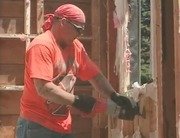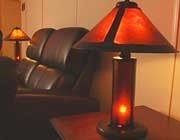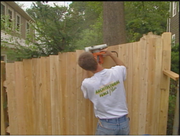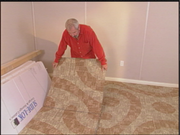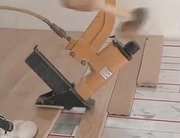And there goes the header piece.
Boy, this is gonna be a beautiful , beautiful finish job, you guys.
So, what we've got here is a three-panel sliding patio door and the makings of a nice back yard, a beautiful garden.
But when we started, what we had here was a typical 85 year old backside of a house with a little door, a little kitchen door and a couple of little windows and nothing much architecturally of any interest.
And of course no view towards this back yard.
Well, after doing the demolition on this back wall, getting rid of a couple of windows and removing the old entry door, We found some very serious rot and insect damage behind the stucco down towards the bottom of the wall, right where the seal is.
Four by six fifteen sixteen footer.
And this takes a little bit of time to deal with, but it's very important to replace that rotted wood with pressure treated lumber so that the house remains structurally sound.
It's good on my end.
Better?
Terrific.
Item two.
Fill them cup one a peen.
You know the.
Right.
I don't want to.
Something.
There you go.
That's where, I'm done.
Good?
Yeah.
With all this evidence of insect damage, we thought it made sense to get some help from George Alan, who started an innovative company close to here in Gloster, Massachusetts.
After his own career as a builder, seeing lots of these problems in New England homes.
Bob, what we do is we have to remove the panels in the basement.
and we exposed the wall area.
What we're doing to protect the seals, because we're so close to the ground here and you have a lot of exposure to termites, carpenter ants and whatever critter that wants to run into the wall.
We're injecting, we're gonna insert into the wall one plug every four feet along the perimeter of the building.
And from that point, so we get great coverage.
We're gonna go into each individual bay, and we're going to drill a quarter inch hole into each individual bay, and inject the Borakia into the wall.
That's going to give us complete saturation of the seal.
That's gonna seep down between the sheathing, the inside of the sheathing and the sill in both the plaster wall and the sill, and it's gonna wrap right around, and it's gonna soak into that wood pretty close to the center of that wood with Borakia.
And it has the glycol in there and the glycol is going to kill any spores that's inside of the wood that's possibly rotting, it's going to kill the rot spore.
And it's gonna prevent the mold and mildew.
OK.
What we're using here, Bob, is a naturally occurring product called Boracare.
It's made from borate.
It grows a lot in Europe, out in the Midwest.
It used in products like Visine, things like that for your eyes, for any kind of wash products.
With, it's something that , because it's naturally occurring the Nicest corporation has put this together with a product that we can use in the wall of a home to prevent termite s and decay and fungi.
Insects get them on them, they actually groom themselves, and then it's lights out.
We have an exterior plug that's designed to go into wood sheeting from three quarters of an inch to two inches.
And this will go though anything from paper thin to up to two inches.
Masonry block, goes into steel panels, it'll go into anything that you need to put it in.
Into a kitchen, commercial kitchen for behind your Prior lathers, where you have a big problem with, possibly cockroaches and different stuff, that's a natural, that comes into a restaurant.
You install these plugs in the backside of these areas.
You get and treat inside the walls where they live.
They don't live in the middle of the floor they live behind the walls, underneath the cabinets, enclosed dark areas.
Where it's damp, you have a constant problem.
This thing is here for, you know, constant treatment.
I turned the pressure way down low for that other stuff.
Clay.
So, Lou, this is not a stock molding that you can just buy at the lumber yard, right?
You guys at Moynihan, had to make this for us.
Correct.
What we did is we took a piece off the old trim.
made a template of it, and then what we did is we cut the knives in our shop to produce this moulding here.
So back at the shop, using a knife like this, the machine can actually mill as much of this moulding as we might need out of whatever lumber we might want.
Whatever species you need, whatever fits the bill.
We can run fifty feet, we can run a thousand feet.
Yeah.
The cost is really tied up in making the knife, right?
Correct, yeah, a set of knives are about $200.00 from start to finish.
So if you're doing a big remodeling project, it makes a lot of sense.
Absolutely.
If you're doing just a smaller one, it might not make as much sense.
Correct.
Yeah, the more, it seems the more you do , the less it gets.
Perfect.
Alright, so this molding also had to be custom cut, right?
Yes, yes, it did.
We also replicated that to match the rest of the trim in the kitchen.
And I'm gonna talk over the noise of the gun for a minute, but anyway, the interesting thing is that, Moynihan Lumber and many regional lumber yards often will offer this kind of service.
Yes.
A lot of places is that have a custom mill workshop will replicate including an odd window.
An odd size window like you've made for us here in this, in what was the little mud room, where we took the door out.
Correct, we took measurements of the windows that were existing, and we made a window to match.
Thanks, guys, this is a thing of beauty.
That's it for today.
Next week we will be putting in a beautiful white cedar backyard fence, a rather small door on the side of the house, and also some radiant heat in the floor of the bathroom.
Until then, I'm Bob Vila.
Thanks for joining us.

